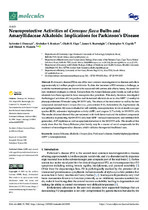Neuroprotective activities of crossyne flava bulbs and amaryllidaceae alkaloids: Implications for parkinson’s disease
Date
2021Author
Omoruyi, Sylvester
Ibrakaw, Abobaker
Ekpo, Okobi
Boatwright, James
Metadata
Show full item recordAbstract
Parkinson’s disease (PD) is one of the most common neurodegenerative diseases and affects approximately 6.3 million people worldwide. To date, the treatment of PD remains a challenge, as available treatment options are known to be associated with serious side effects; hence, the search for new treatment strategies is critical. Extracts from the Amaryllidaceae plant family as well as their alkaloids have been reported to have neuroprotective potentials. This study, therefore, investigated the biological activities of Crossyne flava and its isolated alkaloids in an in vitro MPP+ (1-methyl-4- phenylpyridinium) PD model using SH-SY5Y cells. The effects of the total extract as well as the four
compounds isolated from Crossyne flava (i.e., pancratinine B (1), bufanidrine (2), buphanisine (3), and epibuphanisine (4)) were evaluated for cell viability, neuroprotection, levels of reactive oxygen species (ROS), adenosine triphosphate activity (ATP), and caspase 3/7 activity in SH-SY5Y cells. The results obtained showed that pre-treatment with both the extract and the isolated compounds was effective in protecting the SH-SY5Y cells from MPP+-induced neurotoxicity and inhibited ROS generation, ATP depletion as well as apoptosis induction in the SH-SY5Y cells. The results of this study show that the Amaryllidaceae plant family may be a source of novel compounds for the
treatment of neurodegenerative diseases, which validates the reported traditional uses.

